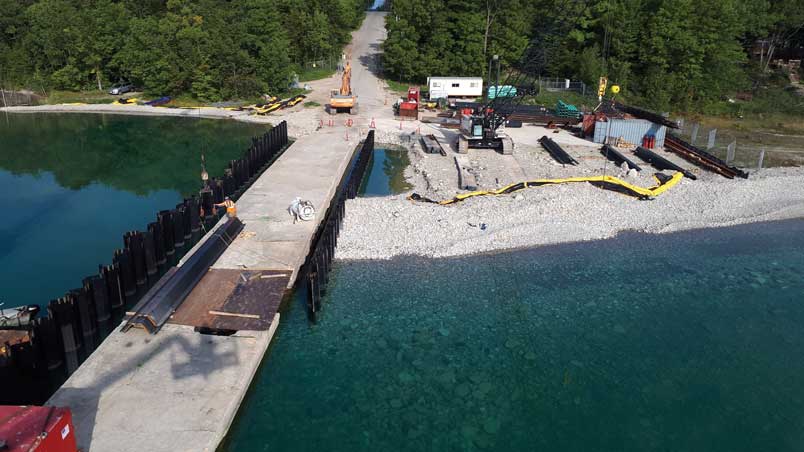
Bulkhead wall for new pier at Cape Croker Park using steel sheet pile
Photos: Dean Construction Co., Ltd.
Cape Croker Park is located on the eastern shore of the Bruce Peninsula on Sydney Bay, in Ontario. The park is owned and operated by the Chippewas of Nawash Unceded First Nation. Encompassing over 520 acres, Cape Croker Park is a recreational facility that includes 315 campsites, hiking trails and a sheltered harbour with dockage for recreational vessels of all sizes. Located on the eastern side of the Bruce Peninsula, Cape Croker Park is open for travellers from the first weekend in May through to Thanksgiving, when it closes for the season.
The Chippewas of Nawash Unceded First Nation realized it was time to rehabilitate an old timber wharf at the park. Due to its age and the harsh winter conditions on Sydney Bay, the wooden wharf was no longer safe for park visitors to use. The Chippewas of Nawash Unceded First Nation was able to secure funding from the Department of Indigenous Services Canada for the rehabilitation project.
The Ottawa office of Stantec Consulting, Ltd., was responsible for the design work on the project. The design consisted of two parallel sheet pile bulkhead walls, encapsulating an existing L-shaped, concrete-capped timber crib wharf.
Dean Construction Co., Ltd. (Dean), of Windsor, Ont., was awarded the contract to reconstruct the wharf. Working with Stantec Consulting on the job, Dean secured the specified steel sheet piling from Nucor Skyline’s Brossard, Que., office. Dean has a long-standing, excellent working relationship with Nucor Skyline and has partnered with them on many projects within the region. For this project, the engineering department at Nucor Skyline consulted on the entire project, providing drawings and suggesting corner pieces for the job. These suggestions helped save time and money on the project.
The coating adds an additional 10 to 20 years of life to the steel sheet piling, giving the AZ 26-700 sheets a life expectancy of 100 years.
The new wharf was built using approximately 400 net tonnage of AZ 26-700 steel sheet piles in lengths of 10 to 15 metres, which were manufactured in Luxembourg by ArcelorMittal. Nucor Skyline often works with ArcelorMittal on jobs in Canada to supply products from Europe. The AZ 26-700 sheet piles, which met A690 specifications, were coated with a polyamine epoxy on both sides to prevent corrosion due to the harsh marine environment. The coating adds an additional 10 to 20 years of life to the steel sheet piling, giving the AZ 26-700 sheets a life expectancy of 100 years.
As the jobsite is a campground, and there is little room on land for the equipment, Dean used spud barges for the equipment and the sheet piles were driven primarily from the barges. Dean used its own equipment and the sheets were driven using a combination of a Dawson hydraulic impact hammer and HPSI 300 and 500 vibratory hammers.
A 24-metre-long obstruction was encountered on the southernmost east-west facing wall while driving the sheet piles. Dean worked quickly with the engineers at Nucor Skyline to develop a braced tie-back solution, which prevented any schedule slippage or standby charges.
Nucor Skyline’s double-channel walers and No. 24 threaded tie-rods completed the connection between the two sheet pile walls and the sheet piles were driven to approximately one metre from the existing wharf perimeter.
Upon completion of the tie-backs, graded, clear stone was placed in the void between the new wall and the existing wharf, as well as up to the bottom elevation of the subsequent concrete work.
Material costs, primarily the foundation of the new wharf, were 51 per cent of the total job cost. Subcontractors hired for the job, both concrete and electrical, were another 28 per cent of the cost of the project. Dean worked with local contractors wherever possible and proposed hiring people from the Chippewas of Nawash Unceded First Nation; two personnel were hired from the First Nation.


Construction began in the fall of 2018, and was completed in the spring of 2019, when the new cast-in-place concrete cope was poured on top of the sheet piles. The concrete deck was poured on top of the granular fill between the walls and the ancillary safety ladders, then fenders and electrical components were installed.
Other works on the site for the 2018 season included dredging, the installation of a precast concrete panel boat ramp and the installation of an eight-metre-wide scour apron, which consisted of 200 to 300 mm fractured stones placed around the sheet pile structure.
Cape Croker Park has been up and running again for two years, and with the help of Dean Construction, Stantec Consulting and Nucor Skyline, the wharf on Sydney Bay is safely usable for all to enjoy for years to come. ![]()
-
From Historic Foundations to Modern Marvels
April 18, 2024 -
Canadian Construction Trends for 2024
April 16, 2024 -
Substance Use in the Trades
April 12, 2024 -
Putting Technology to Work in Your Business
April 12, 2024 -
A Matter of Life or Death
April 12, 2024